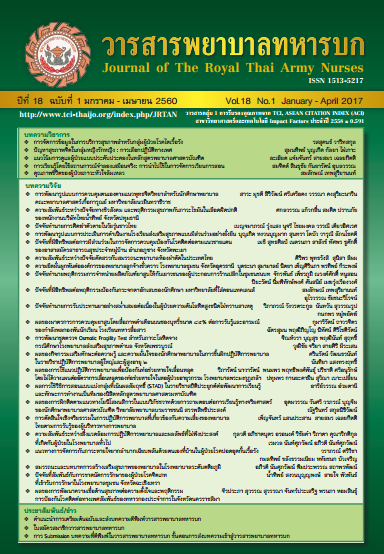ปัจจัยทำนายการรับประทานยาอย่างสม่ำเสมอต่อเนื่องในผู้ป่วย ความดันโลหิตสูงชนิดไม่ทราบสาเหตุ
Keywords:
การรับประทานยาอย่างสม่ำเสมอต่อเนื่อง, โรคความดันโลหิตสูง, สมรรถนะแห่งตน, การรับรู้อุปสรรค, การสื่อสาร ระหว่างผู้ป่วยและบุคลากรทางการแพทย์, medication adherence, hypertension, self-efficacy, perceived barrier to action, patient-provider communicationAbstract
โรคความดันโลหิตสูงเป็นปัญหาสาธารณสุขที่สำคัญเพราะมีความชุกสูงและทำให้เกิดโรคแทรกซ้อนที่เป็นอันตราย การรับประทานยาอย่างสม่ำเสมอต่อเนื่องจะสามารถควบคุมระดับความดันโลหิตได้และชะลอการดำเนินของโรค การวิจัยครั้งนี้มีวัตถุประสงค์ เพื่อศึกษาอำนาจการทำนายของปัจจัยการรับรู้สมรรถนะแห่งตน การรับรู้อุปสรรคในการรับประทานยา การได้รับข้อมูลข่าวสารเกี่ยวกับการรับประทานยาและการสื่อสารระหว่างผู้ป่วยและบุคลากรทางการแพทย์ต่อการรับประทานยาอย่างสม่ำเสมอต่อเนื่องในผู้ป่วยความดันโลหิตสูงชนิดไม่ทราบสาเหตุ จำนวน 128 ราย ที่มารับบริการที่หน่วยบริการสุขภาพระดับปฐมภูมิในกรุงเทพฯ และโรงพยาบาลชุมชนจังหวัดนนทบุรี เก็บข้อมูลโดยใช้แบบสัมภาษณ์ วิเคราะห์ข้อมูลโดยใช้สถิติพรรณนาสัมประสิทธิ์สหสัมพันธ์ของเพียร์สันและการวิเคราะห์ถดถอยพหุคูณผลการวิจัย พบว่า การรับประทานยาอย่างสม่ำเสมอต่อเนื่องในผู้ป่วยโรคความดันโลหิตสูงชนิดไม่ทราบสาเหตุ ส่วนใหญ่อยู่ในระดับต่ำ ร้อยละ 61 การรับรู้สมรรถนะตนเอง การรับรู้อุปสรรคในการรับประทานยา การได้รับข้อมูลข่าวสารเกี่ยวกับการรับประทานยา และการสื่อสารระหว่างผู้ป่วยและบุคลากรทางการแพทย์อยู่ในระดับปานกลาง ร้อยละ 63.30, 66.40, 69.50 และ 69.50 ตามลำดับ และสามารถร่วมกันทำนายการรับประทานยาอย่างสม่ำเสมอต่อเนื่องของตัวอย่าง ได้ร้อยละ 21 อย่างมีนัยสำคัญทางสถิติ ((R2 =.210, p<. 01) โดยพบว่าการรับรู้สมรรถนะแห่งตนสามารถทำนายได้มากที่สุด (β = .352, p< .01) รองลงมาคือการรับรู้อุปสรรคในการรับประทานยา (β = -.202, p <.05)
Factors Predicting to Medication Adherence among Patients with Essential Hypertension
Essential hypertension is a major public health problem because of its high prevalence rate and severity of its complications. Medication adherence enables patients to control their blood pressure levels and prolong the prognosis. The present study aimed at investigating perceived self-efficacy, perceived barriers to medication adherence, reception of information about medication adherence, and patient-provider communication in predicting medication adherence among patients with essential hypertension. The study sample consisted of 128 patients with essential hypertension who sought treatment at primary care units in Bangkok and community hospitals in Nonthaburi province. Data were collected by using an interview format. Descriptive statistics, Pearson’s product moment correlation coefficient, and multiple regression analysis were used for data analysis. The study findings revealed that medication adherence among patents with essential hypertension was at a low level (at 61%). Perceived self-efficacy, perceived barriers to medication adherence, reception of information about medication adherence, and patient-provider communication were at a moderate level (63.30%, 66.40%, 69.50%, and 69.50%, respectively), and they predicted medication adherence in essential hypertensive patients by 21% with a statistical significance (R2 = .210, p < .01). It was found that perceived self-efficacy was the best predictor (β = .352, p < .01), followed by perceived barriers to medication adherence (β = -.202, p < .05).
Downloads
Downloads
How to Cite
Issue
Section
License
บทความหรือข้อคิดเห็นใดใดที่ปรากฏในวารสารพยาบาลทหารบกเป็นวรรณกรรมของผู้เขียน ซึ่งบรรณาธิการหรือสมาคมพยาบาลทหารบก ไม่จำเป็นต้องเห็นด้วย
บทความที่ได้รับการตีพิมพ์เป็นลิขสิทธิ์ของวารสารพยาบาลทหารบก
The ideas and opinions expressed in the Journal of The Royal Thai Army Nurses are those of the authors and not necessarily those
of the editor or Royal Thai Army Nurses Association.






